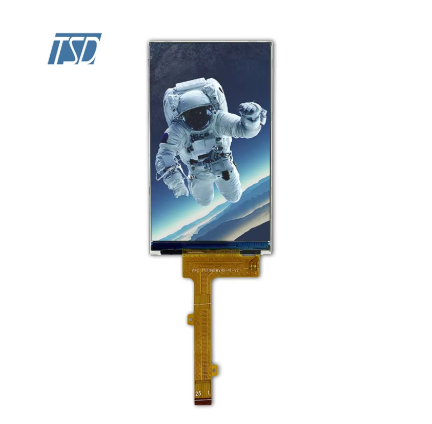Size and Resolution Requirements
Choosing the right size and resolution for an LCD display module is crucial for its successful integration and overall performance. The optimal physical dimensions will depend on the intended Application, necessitating considerations of screen size in inches and aspect ratio (such as 16:9), to ensure seamless fit and functionality within the device. High resolution like Full HD or 4K is essential for sharpness and detail, resulting in better user experiences, especially in applications demanding high clarity such as gaming and professional design tools. Industry data indicates that common LCD sizes and resolutions vary widely based on application, with smartphones generally using screens between 5 to 7 inches and resolutions of up to 1440 x 2960 pixels, while tablets may range up to 11 inches with similar or better resolution.
Brightness and Contrast Ratios
Brightness and contrast ratios are key factors in determining the quality and usability of LCD displays. Brightness, measured in nits, affects visibility in different environments; screens with higher brightness levels perform better in outdoor settings where daylight visibility is necessary. For most indoor uses, a brightness level of around 300-500 nits is sufficient, while outdoor displays often require brighter screens, typically above 1000 nits, to counteract the effects of direct sunlight. The contrast ratio, representing the difference between the darkest and lightest parts of an image, enhances the viewing experience by distinguishing shadows and highlights. LCDs commonly have contrast ratios starting at 1000:1, though industries such as cinematography often look for higher ratios for dynamic image reproduction. User feedback emphasizes the impact of brightness and contrast on user satisfaction, where inadequacies in these aspects can lead to viewing challenges.
Viewing Angles and Panel Technology
The usability of LCD modules heavily relies on their viewing angles, especially in scenarios involving multiple viewers or displays used in public spaces. Wider viewing angles ensure consistent image visibility and color accuracy from different positions. Different panel technologies offer varied benefits in this regard. TN (Twisted Nematic) panels are known for fast response times but suffer from poor color reproduction and limited viewing angles. IPS (In-Plane Switching) panels, however, provide superior color accuracy and wide viewing angles, making them favored in devices like high-end monitors and smartphones. VA (Vertical Alignment) panels serve as a middle ground, offering better contrast and viewing angles than TN panels but falling short compared to IPS panels. Each technology finds its niche based on application requirements; for example, IPS panels are greatly appreciated in graphic design and collaborative workspaces due to their accuracy and wide viewability.
TFT vs. IPS vs. VA: Pros and Cons
When selecting an LCD display module, understanding the differences between TFT, IPS, and VA technologies is essential. TFT (Thin Film Transistor) panels are known for their fast response times, making them ideal for applications requiring quick image transitions, like gaming monitors. However, they often suffer from limited viewing angles. IPS (In-Plane Switching) technology, on the other hand, offers superior color accuracy and wider viewing angles, making them popular in mobile devices where screen quality is paramount. The downside is that IPS panels tend to be more expensive. VA (Vertical Alignment) panels provide deep blacks and good contrast ratios, beneficial for parts of the display industry where rich colors are needed, though they can't match the speed and color accuracy of IPS. In comparing compatibility, gaming monitors often prefer IPS for responsiveness and visual quality, while mobile devices may use TFT for energy efficiency and cost advantages.
Touchscreen Integration Considerations
The integration of touchscreens into devices presents a set of choices and considerations, primarily between resistive and capacitive technologies. Resistive touchscreens, known for their durability and lower cost, are pressure-sensitive and ideal for industrial applications where gloves are commonly used. On the other hand, capacitive touchscreens, which are more responsive to touch and support multi-touch functionalities, are prevalent in consumer electronics like smartphones and tablets due to their superior user experience. Integrating touchscreen functionality affects a device's overall design, often increasing costs but enhancing user interaction. According to market studies, there is a robust trend towards touchscreen interfaces in consumer electronics, driven by users' demand for intuitive and interactive devices.
Interface Compatibility (SPI, LVDS, MIPI)
Choosing the right interface for an LCD display module, such as SPI, LVDS, or MIPI, is critical for seamless integration and optimal performance. SPI (Serial Peripheral Interface) is suitable for lower-speed applications due to its simplicity and ease of use, making it ideal for small systems or applications where high data rates aren't necessary. LVDS (Low Voltage Differential Signaling) supports higher data rates and is typically used in larger displays requiring reliable transmission over longer distances. MIPI (Mobile Industry Processor Interface) is designed specifically for mobile devices, offering fast data transfer in a compact format. Selecting the appropriate interface is vital for achieving the necessary data transfer rates and ensuring compatibility with the host device, as demonstrated by projects where poor choice led to performance bottlenecks.
Temperature Tolerance and Durability
Temperature tolerance is a critical factor when selecting LCD modules, especially in extreme environments. LCD modules must operate effectively in various temperature ranges to ensure reliability in applications exposed to extreme weather conditions. For instance, while TFT LCDs generally function well in temperatures ranging from -20°C to 70°C, monochrome LCDs can withstand broader ranges, from -40°C to 90°C. This makes them ideal for rugged environments that demand high durability. Durability is also crucial, as industrial applications often necessitate resistance to shock and vibration. Poor durability can shorten the lifespan of the module and lead to frequent replacements, increasing overall costs.
Durability isn't confined to temperature tolerance alone but also includes resistance to environmental stressors like shock and vibration. This is particularly important in industrial settings where machinery vibrations or accidental impacts may occur. Modules designed for high durability can maintain their performance, minimizing the risk of operational interruptions. Data shows that modules not adhering to these durability standards often face performance degradation, resulting in decreased efficiency and potential operational downtime. Thus, investing in durable LCD modules ensures long-term reliability and cost efficiency.
Power Consumption and Heat Management
The power consumption of LCD modules directly influences the battery life of portable devices. Modules like TFTs usually require more power due to their vibrant display capabilities, potentially reducing battery longevity in handheld devices. Conversely, monochrome LCDs consume less power, making them preferable for applications where energy efficiency is paramount. The choice of LCD technology should thus align with the device's power requirements to balance performance with energy consumption.
Efficient heat management is essential for maintaining the longevity of LCD modules. Excessive heat can lead to performance issues and mechanical failure. Techniques such as using thermal paste, implementing cooling systems, or embedding heat sinks are practical measures to dissipate heat effectively. On average, LCD modules employing such techniques show extended operational life, sustaining performance by mitigating the risks associated with overheating. Statistics indicate that incorporating these methods significantly reduces the thermal stress on the components, optimizing reliability and lifespan.
Outdoor vs. Indoor Use Cases
Design considerations for LCD modules differ significantly between outdoor and indoor applications. Outdoor displays, such as those used in billboards or transportation systems, require higher brightness levels to ensure visibility under intense sunlight. Additionally, features like weatherproofing and anti-glare treatments are necessary to withstand environmental elements and improve viewing comfort. Indoor displays, however, focus on resolution and color accuracy for applications like retail screens or office monitors, where ambient lighting is controlled.
Successful examples abound, like outdoor displays in Times Square where high brightness and durability are paramount. Studies have demonstrated that user interaction and visibility improve remarkably with displays that are customized for their specific environments. For instance, outdoor retail settings benefit from displays with over 1,000 nits brightness, ensuring clear visibility. Conversely, indoor displays can focus on color precision, enhancing the shopping experience without the need for extreme brightness. Thus, tailoring LCD technology to its setting guarantees optimal user satisfaction and operational performance.
Quality Assurance and Reliability Standards
Certifications and Industry Compliance
Certifications play a crucial role in ensuring the quality and safety of LCD display modules. Key certifications such as CE, RoHS, and UL guarantee that these modules meet industry standards for safety and performance. For example, CE certification ensures compliance with European health, safety, and environmental requirements, while RoHS restricts the use of hazardous substances in electronics. In industries like automotive and medical, specific regulations mandate compliance to prevent reliability issues. Historical data shows that non-compliance can lead to product failures and costly recalls. Thus, adhering to these certifications is essential for maintaining the functionality and reliability of LCD modules.
Manufacturer Reputation and Support
Choosing a reputable manufacturer is vital for obtaining reliable LCD modules. Renowned manufacturers often have a proven track record of delivering dependable Products and providing exceptional post-sale support. Customer Service and comprehensive warranty policies are key factors contributing to long-term customer satisfaction and reduced operational costs. Industry awards and ratings can be indicative of top-performing manufacturers in the LCD market. Researching these accolades can help buyers make informed decisions, ensuring a smoother purchase experience and reliable performance over the product's lifespan.
Warranty and Longevity Testing
A robust warranty is a critical factor when selecting LCD display modules. Typical warranty terms should include substantial coverage length and comprehensive inclusions to protect buyers against defects and malfunctions. Longevity testing under real-world conditions is equally important to assess product reliability over time. Insights from consumer reports and reliability studies highlight the positive impact of rigorous warranty and testing procedures. These measures offer peace of mind to buyers and assure them of the product's durability and efficiency, making it a prudent investment in the long run.
FAQ
What is the ideal size and resolution for an LCD display module?
The ideal size and resolution depend on the application. For smartphones, screens range from 5 to 7 inches with resolutions up to 1440 x 2960 pixels. Tablets may have screens up to 11 inches with similar or better resolution.
How do brightness and contrast ratios affect LCD display quality?
Brightness impacts visibility in various environments, particularly outdoors, while contrast ratios enhance the viewing experience by distinguishing shadows and highlights, crucial in visual-based industries.
What are the differences between TFT, IPS, and VA LCD technologies?
TFT panels offer fast response times but have limited viewing angles, IPS panels provide superior color accuracy and wide viewing angles, and VA panels deliver deep blacks and good contrast ratios, balancing between TFT and IPS benefits.
Which interface is best for integrating an LCD display module?
The best interface depends on the application requirements: SPI for simpler systems, LVDS for larger displays needing reliable transmission, and MIPI for mobile devices demanding fast data transfer.
Why is temperature tolerance important for LCD modules?
Temperature tolerance ensures reliability in extreme environments, preventing performance degradation and increasing lifespan, especially for industrial or outdoor applications.
Table of Contents
- Size and Resolution Requirements
- Brightness and Contrast Ratios
- Viewing Angles and Panel Technology
- TFT vs. IPS vs. VA: Pros and Cons
- Touchscreen Integration Considerations
- Interface Compatibility (SPI, LVDS, MIPI)
- Temperature Tolerance and Durability
- Power Consumption and Heat Management
- Outdoor vs. Indoor Use Cases
- Quality Assurance and Reliability Standards
-
FAQ
- What is the ideal size and resolution for an LCD display module?
- How do brightness and contrast ratios affect LCD display quality?
- What are the differences between TFT, IPS, and VA LCD technologies?
- Which interface is best for integrating an LCD display module?
- Why is temperature tolerance important for LCD modules?




